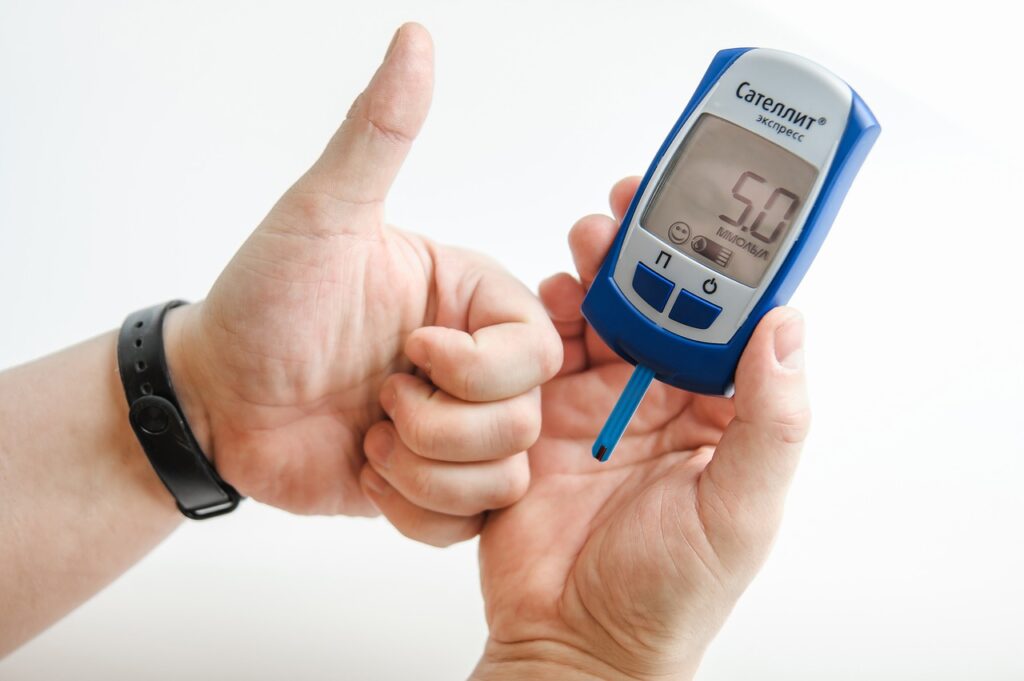
What is Diabetes?
Diabetes is a disease that occurs when your blood glucose, also called blood sugar, is too high. Blood glucose is your main source of energy and comes from the food you eat. Insulin, a hormone made by the pancreas, helps glucose from food get into your cells to be used for energy. Sometimes your body doesn’t make enough or any insulin or doesn’t use insulin well. Glucose then stays in your blood and doesn’t reach your cells.
Over time, having too much glucose in your blood can cause health problems. Although diabetes has no cure, you can take steps to manage your diabetes and stay healthy!!
What are the different types of diabetes?
The most common types of diabetes are type 1, type 2, and gestational diabetes.

Type 1 diabetes
If you have type 1 diabetes, your body does not make insulin. Your immune system attacks and destroys the cells in your pancreas that make insulin. Type 1 diabetes is usually diagnosed in children and young adults, although it can appear at any age. People with type 1 diabetes need to take insulin every day to stay alive.
Type 2 diabetes
If you have type 2 diabetes, your body does not make or use insulin well. You can develop type 2 diabetes at any age, even during childhood. However, this type of diabetes occurs most often in middle-aged and older people. Type 2 is the most common type of diabetes.
Gestational diabetes
Gestational diabetes develops in some women when they are pregnant. Most of the time, this type of diabetes goes away after the baby is born. However, if you’ve had gestational diabetes, you have a greater chance of developing type 2 diabetes later in life. Sometimes diabetes diagnosed during pregnancy is actually type 2 diabetes.
How common is diabetes?
The estimates in 2019 showed that 77 million individuals had diabetes in India, which is expected to rise to over 134 million by 2045. Approximately 57% of these individuals remain undiagnosed. Type 2 diabetes, accounts for a majority of the cases.
Risk Factors
The aetiology of diabetes is believed to be multifactorial.
Non-modifiable risk factors like genetics, age, ethnicity, and family history have been prospectively associated with type 2 diabetes.
Modifiable Risk Factors
The increases in prevalence in most populations have probably been driven by modifiable risk factors like a sedentary lifestyle and/or lack of exercise, increasing prevalence of overweight/obesity, unhealthy diets (increased intake of refined grains, fat, sugar, and sweetened beverages and decreased intake of fruits and vegetables) and habits (smoking and alcohol abuse), exposure to environmental pollutants, altered intrauterine environment and mental health (stress/depression), short sleep duration.
Symptoms
Diabetes symptoms depend on how high your blood sugar is. Some people, especially if they have prediabetes or type 2 diabetes, may not have symptoms. In type 1 diabetes, symptoms tend to come on quickly and be more severe.
Some of the symptoms of type 1 diabetes and type 2 diabetes are:
- Feeling more thirsty than usual.
- Urinating often.
- Losing weight without trying.
- Presence of ketones in the urine. Ketones are a byproduct of the breakdown of muscle and fat that happens when there’s not enough available insulin.
- Feeling tired and weak.
- Feeling irritable or having other mood changes.
- Having a blurry vision.
- Having slow-healing sores.
- Getting a lot of infections, such as gum, skin and vaginal infections.
Tests for type 1 and type 2 diabetes and prediabetes
- Glycated haemoglobin (A1C) test
- Random blood sugar test
- Fasting blood sugar test
- Oral glucose tolerance test
Health impact/Complications
Over time, diabetes can damage the heart, blood vessels, eyes, kidneys, and nerves.
- Adults with diabetes have a two to three-fold increased risk of heart attacks and strokes.
- Combined with reduced blood flow, neuropathy (nerve damage) in the feet increases the chance of foot ulcers, infection and the eventual need for limb amputation.
- Diabetic retinopathy is the most important cause of preventable blindness and occurs as a result of long-term accumulated damage to the small blood vessels in the retina. Close to 1 million people are blind due to diabetes.
- Diabetes is among the leading causes of kidney failure.
- People with diabetes are more likely to have poor outcomes for several infectious diseases, including COVID-19.
Prevention
Lifestyle measures have been shown to be effective in preventing or delaying the onset of type 2 diabetes. To help prevent type 2 diabetes and its complications, people should:
- Achieve and maintain a healthy body weight.
- Be physically active – doing at least 30 minutes of regular, moderate-intensity activity on most days. More activity is required for weight control.
- Eat a healthy diet, avoiding sugar and saturated fats.
- Avoid tobacco use – smoking increases the risk of diabetes and cardiovascular disease.
Diagnosis and treatment
Early diagnosis can be accomplished through relatively inexpensive testing of blood glucose.
Treatment of diabetes involves diet and physical activity along with lowering blood glucose and the levels of other known risk factors that damage blood vessels. Tobacco use cessation is also important to avoid complications.
Interventions that are both cost-saving and feasible in low- and middle-income countries include:
- Blood glucose control, particularly in type 1 diabetes. People with type 1 diabetes require insulin, people with type 2 diabetes can be treated with oral medication, but may also require insulin.
- Blood pressure control.
- Foot care (patient self-care by maintaining foot hygiene; wearing appropriate footwear; seeking professional care for ulcer management; and regular examination of feet by health professionals).
Diabetes Awareness
For some people, diabetes awareness may be about the prevention of the onset of the condition. Healthy eating and more active lifestyles can ward off type 2 diabetes induced by being overweight!
Knowledge is power and by raising awareness about diabetes many great things can be achieved for us all.




